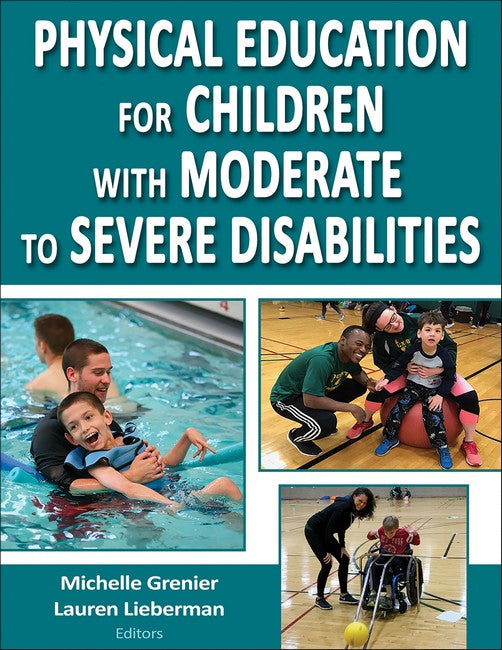Michelle Grenier, PhD, is an associate professor and coordinator of the health and physical education program and adapted physical education program at the University of New Hampshire. She has substantial experience working in the field of physical education and utilizing inclusive strategies for students with disabilities. She is an accomplished researcher and is editor of the text Physical Education for Students With Autism Spectrum Disorders. Dr. Grenier is internationally recognized for her work on inclusion and has presented throughout the United States. She enjoys running, cycling, swimming, and traveling the world to meet others who share her professional and personal interests. Lauren J. Lieberman, PhD, is a distinguished service professor at The College at Brockport, State University of New York. She has taught higher education since 1995 and previously taught in the Deafblind Program at Perkins School for the Blind. She is fluent in sign language and used sign as her language in earning her PhD. She infuses sign language throughout her courses. Lieberman has written 18 books on adapted physical education and more than 118 peer-reviewed articles. She started Camp Abilities, an overnight educational sports camp for children with visual impairments. This camp is now replicated in 18 states and eight countries. Lieberman is past chair of the Adapted Physical Activity Council (APAC). She is currently on the board of the division of recreation and sport for the Association for the Education and Rehabilitation of the Blind and Visually Impaired (AER), and she serves on the board of the United States Association of Blind Athletes (USABA). She acts as a consultant for the New York Deaf-Blind Collaborative. In her leisure time, she enjoys playing Ultimate Frisbee, biking, running, kayaking, hiking, reading, and playing the guitar.
Request Academic Copy
Please copy the ISBN for submitting review copy form
Description
Foreword Preface Acknowledgments Part I: Best Practices for Engaging All Students Chapter 1: Understanding Severe Disabilities and Universal Design for Learning Severe Disabilities Individuals with Disabilities Education Act Universal Design for Learning Summary Chapter 2: Collaborative Processes in Physical Education The Practice of Collaboration Becoming Part of the Education Team Developing Adapted Physical Education Goals Through Shared Goals Steps in the Collaborative Process Summary Chapter 3: Assessment Strategies Functional Assessment of Students With Severe Disabilities Rubrics Task Analysis Assessment Ecological Task Analysis Basic Skills Assessment Summary Chapter 4: Communication Practices That Enhance Participation Considerations for Communication Practices in Physical Education Types of Communication Practices Summary Chapter 5: Peer Tutoring Selecting Peer Tutors Training Peer Tutors Evaluating the Tutoring Experience Summary Chapter 6: Paraeducators in Physical Education Understanding the Paraeducator's Role Training for Paraeducators Ideas for Acknowledging Paraeducators' Contributions Summary Chapter 7: Creating Accessible Equipment Adapting Equipment With SENSE Six Ss for Adapting Equipment Summary Part II: Participation for All in Sport Activities Chapter 8: Foundational Skills and Sensory Integration Understanding Sensory Integration Theory Developing Foundational Skills Putting Your Plan Into Action Summary Chapter 9: Disability Sport in Physical Education Sport Opportunities for Children With Severe Disabilities Role of the Teacher and Coach in Disability Sport Summary Chapter 10: Modified Programming in Physical Education Establishing Disability Sports Within the Physical Education Curriculum Assessment in Disability Sport Summary Chapter 11: Transitioning to Recreational Opportunities Beyond School Transition Services and Individuals' Rights Initiating the Transition Plan Transition Processes in Physical Education Training Personnel for Community-Based Programs Summary Chapter 12: Aquatics for Children With Disabilities Benefits of Aquatics Medical Issues, Precautions, and Safety Issues Assessment in Aquatics Planning Goals and Objectives Teaching and Safety Strategies Transitioning to Aquatics in the Community Summary Part III: Sample Lessons Using Universal Design for Learning Chapter 13: Team Sports and Target Games Soccer: Passing Basketball: Spot Remover Hockey: Rip Off Track and Field: Hurdling Golf: Putting Golf: Stations Golf: Alien Invasion Throlf (Throwing Golf) Bowling for Junk Bowling: Battleships Bowling for Bucks Archery: Safety First Archery: Add It Up Chapter 14: Lifetime and Health-Related Activities Hand Function Challenges Hand Functions for Sports Scooter Train Climbing Wall: Periwinkle Rescue Horseshoes Bicycling: Rules of the Road Tennis: Forehand Stroke Tabletop Shuffleboard Personal Fitness Plan Appendix: Resources

